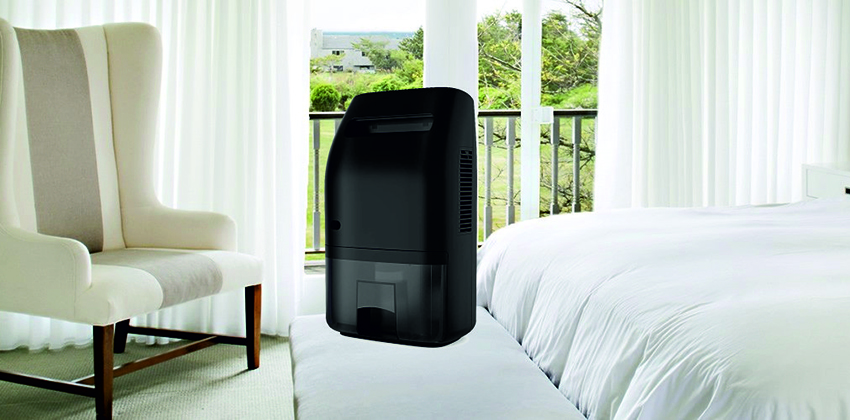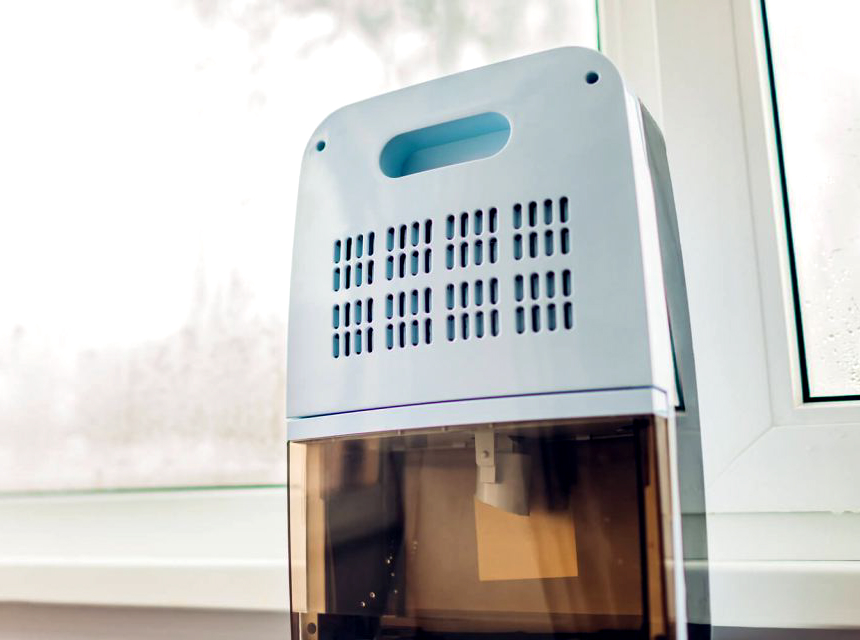

Dehumidifiers may freeze up because of various issues that we have discussed in this article. The causes may range from a faulty humidistat to dirty coils and filters. Running a frozen dehumidifier can make it malfunction and break down completely.
To understand how to diagnose and fix dehumidifier icing, you need to know how a dehumidifier works. We have explained the mechanism of a dehumidifier as well as the major causes of a frozen dehumidifier and the steps you can take to defrost it. We have also covered popular dehumidifier brands and the main reasons they might freeze up.
There are a number of reasons why a dehumidifier keeps icing up. The most common causes why a dehumidifier keeps icing up are incorrect operating temperature, filter issues, debris on coils and obstruction that leads to insufficient airflow.
A dehumidifier removes excess moisture from the air. A fan draws air into the humidifier and a faulty one could be the reason for a dehumidifier freezing up from inadequate airflow.
In a dehumidifier, air passes the condenser coils after passing the evaporator coils and comes out drier than before. When the warmer outside air passes the cold evaporator coils, condensate forms on the coils as the fan draws moisture from the air. The moisture then drips into the reservoir at the base of the dehumidifier.
The best dehumidifier for basements reduces humidity levels to relative levels between 30% and 50%. The air expelled by a dehumidifier is drier but the same temperature as the ambient air.
Further in this troubleshooting guide, we will explain how to stop your dehumidifier from icing up. Meanwhile, let us examine the major causes of a malfunctioned dehumidifier.
Low levels of refrigerant fluid: The compressor pumps the pressurized refrigerant fluid continuously to keep the evaporator coils cold. The coils may develop tiny cracks over time and cause the fluid to leak out.
Defective fan: A dirty fan or a fan with a broken blade may not draw air. In this case, you should remove any debris and then replace the blade.
Limited airflow: If the fan is working but your dehumidifier is icing up, the problem could be dust, lint or pet fur that is blocking the airflow. You can reduce debris, dust, pollen or pet fur in your dehumidifier with an air purifier such as Alen BreatheSmart 45i that comes with a True HEPA filter to remove 99.9% of particles greater than 0.1 microns.
Full tank: Look for reputable dehumidifiers with auto shut-off safety feature that turns off the appliance when the water tank is full to prevent spillage.
Overloaded compressor: The compressor is a core part of the dehumidifier. The compressor can overheat if it is overworked or if the coils have heavy frost. That is why you might find your dehumidifier icing up on bottom end.
Faulty electrical components: A dehumidifier could malfunction because of loose wiring, damaged electrical parts or a digital touch pad that stops working.
High levels of humidity: Mayo Clinic Trusted Source Humidifiers: Ease skin, breathing symptoms - Mayo Clinic Humidifiers can ease problems caused by dry air. But they need regular maintenance. Here are tips to ensure your humidifier doesn’t become a health hazard. www.mayoclinic.org reinforces the importance of using a dehumidifier to prevent the growth of harmful bacteria, mold and dust mites and condensation forming on floors, walls and other surfaces. A dehumidifier might not turn on if you set the desired humidity level too high since the humidity in your room will not be high enough to activate the appliance.
If you find a dehumidifier freezing up, there are several ways you can go about fixing it. The following are the most common dehumidifier icing up fixes that apply to many brands that are currently on the market.
If the preset humidity levels are not too high and your dehumidifier is icing up on bottom, you should check the humidistat. A dehumidifier may freeze up because of a faulty humidistat that makes the compressor overwork. This causes an iced up dehumidifier because the coils are too cold and a defective humidistat cannot monitor the levels of moisture in the air to turn on the machine or to activate anti-frost mode.
Confirm that the dehumidifier is configured for a humidity level that is lower than the one in your room, and that it is in the correct position.
Test the humidistat with a multimeter for continuity. You may have to replace a broken humidistat with a new one from the manufacturer or a hardware store if the multimeter has null readings.
Harvard Health Publishing Trusted Source Easy ways you can improve indoor air quality - Harvard Health Improving indoor air in the winter months by using some simple strategies, such as vacuuming regularly, can help cut down on allergies and respiratory problems. www.health.harvard.edu notes that you can improve indoor air quality by installing a dehumidifier in damp areas such as basements and bathrooms to prevent the growth of mold. If you are wondering how to stop a dehumidifier from icing up, you should check the filter.
An excessively dirty air filter will restrict airflow and result in the dehumidifier freezing up. It will also cause obstruction in airflow as the coils overwork or clog and damage the internal components of your machine.
Consider cleaning your washable air filter regularly with water and dish soap as a dehumidifier icing up fix and replacing the filter at least twice a year.
Why is my dehumidifier icing up on bottom? Another potential reason is that the temperature of your room is too low.
The American Society of Heating, Refrigerating and Air-Conditioning Engineers (ASHRAE) recommends indoor relative humidity be maintained at or below 65% with no prescribed lower humidity limit.
A dehumidifier should be in a room with the recommended temperature, above 65°F, to avoid the dehumidifier freezing up.
If a dehumidifier keeps icing up, you should increase the room temperature before using the machine. A dehumidifier icing up fix is to wait for the ice on the coils to thaw and then unplug the machine and clean any remaining ice and dust with a rag.
Many dehumidifier manufacturers do not recommend using their products in areas that are below 60 °F. However, you can check out the best low-temperature dehumidifiers that are specifically designed for colder climates such as in winter. These models are also suitable for crawl spaces and basements where temperatures are typically low.
If you find your dehumidifier freezing up despite the ambient temperature being above 65 °F, It might have a faulty evaporator fan motor affecting air circulation.
A defective motor or a fan with bent or loose blade will restrict airflow over the coils and prevent the water from dripping to the water tank.
Replace the fan motor, if need be, to optimize proper distribution of air.
How do I stop my dehumidifier from icing up? Ensure that the coils are clean to operate properly and maintain constant temperature.
Dehumidifiers work best in warmer areas because the big difference between the ambient temperature and the temperature of the cold coils facilitate moisture extraction and proper drainage of the collected water.
Dehumidifier coils will accumulate layers of dirt, dust and pet hair over time unless you clean the air filter regularly. Dirty coils hinder proper air circulation and reduce the effectiveness of the coils to cool or heat the air.
Dirty coils may also cause dehumidifier overheating and freezing up. Remove dirt and debris on the coils with a clean rag, taking care not to damage the fragile fins by folding or bending them.
We also recommend having an air purifier that can remove most particles in the air. Many users recommend the programmable ETL-listed Dyson Pure Cool™ TP01 that is available with multiple airflow settings, a magnetized remote control and a 2-year warranty to purify rooms that are up to 300 square feet.
Some brands are more likely to have certain issues that could be responsible for a dehumidifier freezing up. Let us take a brief look at a few popular brands and what you can do to stop your dehumidifier from icing up.
The reasons for a Frigidaire dehumidifier icing up include dirty or clogged filters that restrict air circulation. Clean or replace the filter. Limited airflow can also be caused by vents that are obstructed by dust particles or objects near the dehumidifier. Make sure the fan blade and blower wheel are spinning freely. Next, test the fan motor and replace it if it is defective.
An energy-efficient dehumidifier should maintain a relative humidity that is not lower than 45% which is the limit value for the growth of mites Trusted Source WHO Guidelines for Indoor Air Quality: Dampness and Mould Moisture control and ventilation www.ncbi.nlm.nih.gov .
You should allow 12 to 18 inches of space above Hisense dehumidifiers with top louvers or around the back and sides of the models that feature a back louver to fix a Hisense dehumidifier icing up.
If your Toshiba dehumidifier is icing up, check if the room temperature is between 41°F and 90°F and the humidity is between 30% and 80%. You could also test the humidistat and the overflow switch with a volt-ohm meter for a dehumidifier icing up fix. Another reason for a frozen Toshiba dehumidifier is loose electrical components and short-circuited internal wiring.
Little to no airflow and leaking refrigerant fluid are the potential causes of hOmeLabs dehumidifiers icing up on the bottom. You can troubleshoot these issues with the steps we have described in this article. If you want more options for winter, we have the best dehumidifiers for bedrooms; these models are portable with numerous positive ratings by users and some of the dehumidifiers are designed for cooler climate.
Danby also provides dehumidifiers that can operate at temperatures that are as low as 41°F, similarly to hOmeLabs. A Danby dehumidifier could be icing up because there is not enough clearance around the air inlets and the dehumidifier cannot draw sufficient air from the room. Place the appliance on a smooth, level surface and allow for a minimum of 16 inches around the vents.
Ice may form on the evaporator coils if they become too cold in an environment that is outside the recommended temperature range of 41°F to 90°F that prevents an LG dehumidifier from icing up. When that happens, the compressor stops and the Auto Defrost function turns on automatically to fix the frozen appliance caused by cold temperatures.
As we have seen, there are many causes of a malfunctioned dehumidifier. They include an overworked compressor, a faulty fan or electrical part, insufficient airflow, or a full tank that needs to be emptied.
We have also provided dehumidifier icing up fixes that would help when the appliance freezes up, including tips for common issues with some top brands. To solve dehumidifier icing problems, you must start by identifying the problem because it could be dirty coils or filter, a room that is too cold, a defective humidistat or fan motor, or electrical failure. Some solutions might require help from a qualified HVAC technician and some components might need replacement if they are too damaged to avoid compromising the performance of your dehumidifier.





